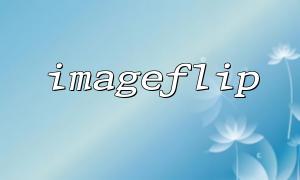When using PHP for image processing, the imageflip function is often used for image flip operations. It can help developers easily flip images vertically or horizontally. However, when performing flip operations, we often care about the quality of the image, especially when the image is processed multiple times, the quality may decline. So, how to ensure that the quality of the image is not affected when flipping images using PHP's imageflip function? This article will introduce you in detail.
The imageflip function is a function provided in PHP's GD image processing library for flipping images. Its syntax is as follows:
int imageflip ( resource $image , int $mode )
$image : Image resource (image resource returned by imagecreatefrom...() function).
$mode : Flip mode, which can be the following:
IMG_FLIP_HORIZONTAL : Flip horizontally.
IMG_FLIP_VERTICAL : Flip vertically.
IMG_FLIP_BOTH : Flip horizontally and vertically at the same time.
The flip operation will not have a significant impact on image quality in essence. However, during image processing, frequent operations such as saving and converting formats may lead to a decline in image quality. This is because images may be compressed every time they save, especially for images in JPEG format.
To avoid losing image quality during flipping, we need to take the following methods:
Try to use lossless compression formats (such as PNG, GIF) to save images. In this way, when the image is saved after each processing, there is no loss of quality due to compression.
$image = imagecreatefromjpeg('image.jpg'); // load JPEG image
imageflip($image, IMG_FLIP_HORIZONTAL); // Horizontal flip
imagepng($image, 'flipped_image.png'); // use PNG Format save
imagedestroy($image); // 销毁image资源
If you have to save the image in JPEG format, you can control the compression quality of the image through the quality parameters of the imagejpeg function to avoid quality loss due to excessive compression. The value of this parameter can range from 0 to 100, where 100 represents the highest quality (minimum compression).
$image = imagecreatefromjpeg('image.jpg'); // load JPEG image
imageflip($image, IMG_FLIP_HORIZONTAL); // Horizontal flip
imagejpeg($image, 'flipped_image.jpg', 90); // Set high quality parameters to save
imagedestroy($image); // 销毁image资源
In this example, we set the quality parameter of the imagejpeg function to 90 to ensure that the flipped image does not lose too much quality when saved.
If the image quality is still not satisfactory after flipping the image, you can consider resizing the image and using the appropriate resolution to further optimize the image quality. With functions such as imagescale or imagecopyresampled , the image can be resampled to ensure that it still maintains a good visual effect after scaling.
$image = imagecreatefromjpeg('image.jpg'); // loadimage
$image = imagescale($image, 800); // 调整image大小,Ensure clarity
imageflip($image, IMG_FLIP_HORIZONTAL); // Horizontal flip
imagejpeg($image, 'flipped_image_resized.jpg', 90); // 保存调整后的image
imagedestroy($image); // 销毁image资源
In this way, we ensure that the image not only maintains its original quality after flipping, but also allows size adjustments when necessary.
While the PHP GD library is feature-rich in image processing, it may have some limitations on some complex operations such as high-quality image rotation and flip. If you need higher quality image processing, consider using a more advanced image processing library such as Imagick , which supports higher quality image editing.
$imagick = new Imagick('image.jpg');
$imagick->flipImage(); // 翻转image
$imagick->writeImage('flipped_image_imagick.jpg'); // 保存image
Although PHP's imageflip function itself does not directly affect image quality, when performing image flips and other operations, the quality of the image depends on the image's saving format and compression method. To ensure that the flipped image quality is not affected, we can take the following measures:
Use lossless compression formats (such as PNG).
Adjust the compression quality when saving JPEG format.
Resize the image as needed to avoid blur caused by scaling.
Consider using a higher quality image processing library, such as Imagick.
Through these methods, we can maximize the quality of the image when performing image flip operations.















